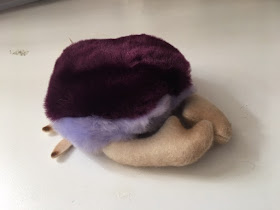Despite producing many snow-related dolls, animals, and accessories in the prewar period, it was not until 1955 that Steiff produced its first actual snowman. This fellow was 25 cm, very plump, and made from white wool plush. His flat feet, designed for standing, had felt pads. He wore a red felt hat and an orange felt scarf, had white woolie buttons down his front, and carried a tiny Christmas tree in his hands. His face came to life with black glass eyes and a dimensional nose and mouth. His article number 7525, corresponded to 7 = in caricature, 5 = wool plush, and 25 = 25 cm tall. He was made as an exclusive for the US market, is insanely rare, and tops the wish lists of many collectors today. The most recent publicly documented sale Steiffgal could find was in January, 2020 when a nice example sold for $1,143 on eBay. The picture on the left is from Worthpoint.
Steiff's next snowman was also a hands down rarity. In 1964, Steiff introduced its Sneba Snowman puppet. He was 17 cm, unjointed, and made from white dralon. His fingertips and head were stuffed with excelsior. His face was detailed with black eyes, an orange felt nose, a red stitched mouth, and a touch of pink blush on his cheeks. He had two black "coal" woolen pompoms on his chest, and his proper topper was a black felt hat. Sneba was made for only one year and is one of the most sought after postwar puppets as well as items. Like his wool plush cousin from the 1950s, he is as rare as hen's teeth. The picture on the left is from Steiffgal's collection.
It would not be until the 1990s that snowmen would appear again in the Steiff line, but this time with more regularity. The largest standard line one to date was the company's 32 cm Teddy Bear Snowman from 1996. He was made from white mohair, head and arm jointed, and wore a black felt top hat. His face was detailed with an orange mohair nose and black button eyes. His accessories included matching black buttons down the front of his body and a broom made from wood and mohair. A few years later, In 2001, the company produced a series of 21 cm snowmen, including one wearing a blue and white cap and scarf for the German market, and one wearing a green and red cap and scarf for the American market. And perhaps the most appealing example from that era was the company's 18 cm Snowman and Raven duo, which was produced in an edition size of 3,000 pieces in 2002-2003. These happy friends from Steiffgal's collection are pictured here on the left.
Given their universal charm, it was no surprise that Steiff produced smaller scaled mohair snowmen as holiday ornaments. An early, if not the earliest one, was a 12 cm, arm and head jointed version wearing a red top hat and carrying a straw and wooden broom made as an exclusive for Disney in 1998. A somewhat similarly designed version in 13 cm but wearing a black top hat was made as a limited edition for the USA in 5,000 pieces that same year. In 1999, a 12 cm version wearing a blue enameled hat and carrying a tiny Christmas tree topped many Steiff collector's holiday wish lists. And more recently, the company's "Mr. Winter" white mohair snowman ornament from 2016 held two ski poles; this frosty friend on the go is pictured here on the left. The image is from Amazon.com.
Snowmen were also produced by Steiff as novelties and licensed articles, including Olaf from Disney's Frozen. It's kind of interesting to note that Steiff never made a woolen miniature snowman, even though the pom-pom format would have worked well with their traditionally ball-like forms. A fun novelty example - based on a legacy toy pattern from the turn of last century - was the company's limited edition Roly Poly snowman from 2005. He was 18 cm tall, made from white mohair, and was head and arm jointed. He wore a black felt hat and carried a broom. His face came to life with black button eyes, a red button nose, a red embroidered mouth, and a pipe. Within the last few years, Steiff created a series of mohair and plush snowmen based on the Snowman made famous by English illustrator and author Raymond Briggs. A particularly charming one from this collection was a 13 cm tall, white mohair ornament. Like his namesake, he wore a matching woolen scarf and hat. He was detailed with black button eyes, an orange embroidered mouth, and a black embroidered mouth. He had three black embroidered buttons on his chest, and a white ribbon sewn into his back for hanging. This ornament was made in an edition size of in 2015 as a special for the UK and Ireland. The picture on the left is from Steiffgal's collection.
Steiffgal hopes this snowman seminar has melted your heart, just a bit, in the most delightful way possible.
Have a question about one of your Steiff treasures? Let's talk! Click here to learn more.
|




















